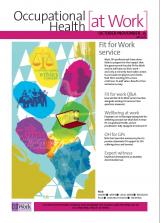October/November 2015 (vol. 12/3)
ContentsFeaturesNewsLegal
NewsResearch DigestResearch PlusCPD
Research Plus
Workplace exercise – a randomised trial
Physical exercise at work significantly reduces ‘perceived physical exertion’ – defined as the balance between physical work demands and the physical capacity of the individual – compared with exercise programmes undertaken at home, according to a cluster randomised controlled trial. It involved 18 departments in three Danish hospitals. In total, 200 female healthcare workers were randomly assigned (by department) either to a 10-week workplace or home-based fitness programme, both consisting of physical exercises for 10 minutes, five times a week. The workplace group had supervised and group-based high-intensity strength training using elastic resistance bands and kettle-bell weights. The home-exercise group received training equipment and instruction posters. Both groups were invited to attend ergonomic training sessions. Those in the workplace group experienced a moderate and statistically significant reduction in perceived physical exertion during work (0.77 points on the 10-point Borg CR10 scale) – the effect was greater than recorded in the home-exercise group (p < 0.01). A small reduction in perceived physical exertion in the home-exercise group was not statistically significant. Adherence to the five sessions was 45% in the workplace group and 21% in the home-exercise group, which may have explained the superior results in the former.
Scandinavian Journal of Public Health 2015; online first: doi: 10.1177/1403494815590936.
Occupational Health at Work October/November 2015 (vol. 12/3) pp34



